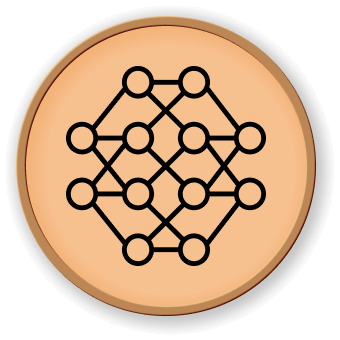应用非负矩阵分解(NMF)
我们将使用两种不同的目标函数应用非负矩阵分解(NMF):弗罗贝尼乌斯范数(Frobenius norm)和广义库尔贝克 - 莱布勒散度(generalized Kullback-Leibler divergence)。后者等同于概率潜在语义索引(Probabilistic Latent Semantic Indexing)。
from sklearn.decomposition import NMF
n_components = 10
n_top_words = 20
init = "nndsvda"
## 拟合NMF模型
print(
"使用tf - idf特征拟合NMF模型(弗罗贝尼乌斯范数),"
"n_samples = %d 且 n_features = %d..." % (n_samples, n_features)
)
nmf = NMF(
n_components=n_components,
random_state=1,
init=init,
beta_loss="frobenius",
alpha_W=0.00005,
alpha_H=0.00005,
l1_ratio=1,
).fit(tfidf)
## 绘制NMF模型的前几个关键词
def plot_top_words(model, feature_names, n_top_words, title):
fig, axes = plt.subplots(2, 5, figsize=(30, 15), sharex=True)
axes = axes.flatten()
for topic_idx, topic in enumerate(model.components_):
top_features_ind = topic.argsort()[: -n_top_words - 1 : -1]
top_features = [feature_names[i] for i in top_features_ind]
weights = topic[top_features_ind]
ax = axes[topic_idx]
ax.barh(top_features, weights, height=0.7)
ax.set_title(f"主题 {topic_idx +1}", fontdict={"fontsize": 30})
ax.invert_yaxis()
ax.tick_params(axis="both", which="major", labelsize=20)
for i in "top right left".split():
ax.spines[i].set_visible(False)
fig.suptitle(title, fontsize=40)
plt.subplots_adjust(top=0.90, bottom=0.05, wspace=0.90, hspace=0.3)
plt.show()
tfidf_feature_names = tfidf_vectorizer.get_feature_names_out()
plot_top_words(
nmf, tfidf_feature_names, n_top_words, "NMF模型中的主题(弗罗贝尼乌斯范数)"
)
## 使用广义库尔贝克 - 莱布勒散度拟合NMF模型
print(
"\n" * 2,
"使用tf - idf特征拟合NMF模型(广义库尔贝克 - 莱布勒散度),"
"n_samples = %d 且 n_features = %d..."
% (n_samples, n_features),
)
nmf = NMF(
n_components=n_components,
random_state=1,
init=init,
beta_loss="kullback-leibler",
solver="mu",
max_iter=1000,
alpha_W=0.00005,
alpha_H=0.00005,
l1_ratio=0.5,
).fit(tfidf)
## 绘制使用广义库尔贝克 - 莱布勒散度的NMF模型的前几个关键词
tfidf_feature_names = tfidf_vectorizer.get_feature_names_out()
plot_top_words(
nmf,
tfidf_feature_names,
n_top_words,
"NMF模型中的主题(广义库尔贝克 - 莱布勒散度)"
)
## 拟合MiniBatchNMF模型
from sklearn.decomposition import MiniBatchNMF
batch_size = 128
print(
"\n" * 2,
"使用tf - idf特征拟合MiniBatchNMF模型(弗罗贝尼乌斯范数),"
"n_samples = %d 且 n_features = %d,batch_size = %d..."
% (n_samples, n_features, batch_size),
)
mbnmf = MiniBatchNMF(
n_components=n_components,
random_state=1,
batch_size=batch_size,
init=init,
beta_loss="frobenius",
alpha_W=0.00005,
alpha_H=0.00005,
l1_ratio=0.5,
).fit(tfidf)
## 绘制使用弗罗贝尼乌斯范数的MiniBatchNMF模型的前几个关键词
tfidf_feature_names = tfidf_vectorizer.get_feature_names_out()
plot_top_words(
mbnmf,
tfidf_feature_names,
n_top_words,
"MiniBatchNMF模型中的主题(弗罗贝尼乌斯范数)"
)
## 使用广义库尔贝克 - 莱布勒散度拟合MiniBatchNMF模型
print(
"\n" * 2,
"使用tf - idf特征拟合MiniBatchNMF模型(广义库尔贝克 - 莱布勒散度),"
"n_samples = %d 且 n_features = %d,batch_size = %d..."
% (n_samples, n_features, batch_size),
)
mbnmf = MiniBatchNMF(
n_components=n_components,
random_state=1,
batch_size=batch_size,
init=init,
beta_loss="kullback-leibler",
alpha_W=0.00005,
alpha_H=0.00005,
l1_ratio=0.5,
).fit(tfidf)
## 绘制使用广义库尔贝克 - 莱布勒散度的MiniBatchNMF模型的前几个关键词
tfidf_feature_names = tfidf_vectorizer.get_feature_names_out()
plot_top_words(
mbnmf,
tfidf_feature_names,
n_top_words,
"MiniBatchNMF模型中的主题(广义库尔贝克 - 莱布勒散度)"
)




